OHIO'S JUDICIARY
How the Courts were Created
Territorial Courts.--The Judiciary under the First Constitution.—Supreme and Common Pleas Courts.—The Duties of the Judges.—Enlargement of the Judicial System under the Constitution of 1851.—Courts Created by the Legislature.
SINCE that breezy day in April, 1788, shortly after the arrival of the first settlers on the soil of the Northwestern Territory, when Colonel Return J. Meigs, Sr., drafted the first laws governing the first settlements of Ohio, up to the present time, the citizens of Ohio have had every reason to be proud of their courts. The word of Governor Joseph Vance, in his inaugural address on the 13th of December, 1836, stands good today : "I have again and again whilst on business in the Eastern cities, heard our judiciary spoken of in terms that make me proud that I was a citizen of Ohio. 'No collusion or fraud, sir,' says an eminent merchant of one of our Eastern cities, 'can stand before your judiciary.' This is the character, gentlemen, that causes capital to seek employment here. This is the character that gives security to our rights, and value to our property ; and to these combined courses are to be attributed a large portion of the flowing prosperity that is felt throughout every portion of our commonwealth."
The government for the Northwestern Territory was created by Congress in October, 1787, and in April of the following year the first settlers began to arrive in the newly' opened country. Their arrival marked the beginning of a new epoch in the history of the United States. With the founding of the present city of Marietta, Ohio, a new empire was born. In the absence of the Governor and Judges, who were to form the law-giving power, and until their arrival, Colonel Return J. Meigs furnished the necessary laws for the new settlement. He drafted a code of regulations on common foolscap, which he tacked to the blazed trunk of a large oak tree, where it was read and indorsed by all the settlers. History does not record a single infraction of those rules. The Governor, with a majority of the court, arrived at Marietta two months later, and from that moment the official government of the territory was effective. The ordinance of 1787, which created the "Territory northwest of the river Ohio," provides that there should be appointed a court to consist of three Judges, any two of whom to form a court, who shall have a common law jurisdiction, and reside in the district, and have therein a freehold estate, in five hundred acres of land, while in the exercise of their offices ; and their commission shall continue in force during "good behavior." These Judges, together with the Governor, were to select from the civil and criminal laws of the original States such laws as they deemed suitable for the territory, and were given the power to promulgate such laws, and to enforce them, until they should he amended or repealed by a General Assembly, to be later organized according to the provisions of the ordinance under which they were appointed.
In accordance with the provisions of this ordinance Congress did, on the 16th of October, 1787, elect as Judges for the Northwestern Territory, Samuel Holden Parsons, John Armstrong and James Mitchell Varnum. In the place of Mr. Armstrong, who declined the appointment, Congress appointed, on the r9th of February, 1788, Mr. John Cleves Symmes. The first Territorial Judges (in 1787-1788) were, therefore, Samuel Holden Parsons, James Mitchell Varnum and John Cleves Symmes. The salaries of the Judges were fixed by Congress, in an act bearing the date of October 8, 1787, at $800 per annum. President George Washington, in a message to the Senate of the United States, bearing the date of New York, August 18, 1789, nominated as Judges of the Northwest Territory, "in accordance with the law re-establishing the government of the Northwest
- 227 -
Territory," Samuel Holden Parsons, John Cleves Symmes and William Barton. Mr. Barton, who was appointed to fill the vacancy caused by the death of Judge Varnum, the month previous, himself declined the appointment, and on the 8th of September, the Senate completed the reorganization of the court by confirming the nomination of George Turner as Associate Justice. The court thus constituted in 1789, and acting under the Constitution of the United States, consisted of Judges Samuel Holden Parsons, John Cleves Symmes and George Turner. Judge Parsons, then Chief Justice, was drowned in November, 1789, while returning home after completing a treaty with the Indians of the Western Reserve, and the President nominated as his successor on the bench Rufus Putnam, of Marietta, whose nomination was promptly confirmed by the Senate. The court as thus organized served from 1790 to 1796, when Judge Putnam left the bench, being appointed to the office of Surveyor General by President Washington, who, in the same message to the Senate, nominated Joseph Gilman to the Judgeship. Two years later, in 1798, Judge Turner resigned.
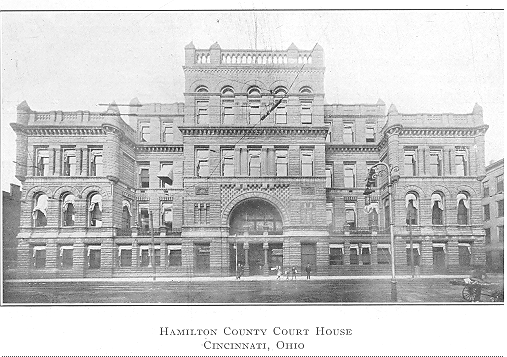
HAMILTON COUNTY COURT HOUSE
CINCINNATI, OHIO
He was succeeded by Return Jonathan Meigs, Jr. These Judges continued to serve until the admission of the State of Ohio into the Union, in 1803, and until the organization of the Supreme Court of Ohio.
The courts of Ohio may be classified in to five groups : First, the Supreme Court of Ohio ; second, the Circuit Courts ; third, the Courts of Common Pleas ; fourth, the Probate Courts, and, fifth, the courts of the Justices of the Peace. The Supreme Court, Court of Common Pleas and the Court of the Justices of the Peace were created by the first Constitution of Ohio, which was framed by the Constitutional Convention in Chillicothe in November, 1802, shortly before the admission of the State into the Union, while the Circuit Courts were brought into existence by provisions of the second Constitution of 1851 nder which the courts now operate. Under the Constitution of 1802 the number of Judges of the Supreme Court was the same as under the territorial form of government, three, with the power vested
- 228 -
in the General Assembly to authorize the selection of an additional Judge, at the discretion of that body. These Judges were to be elected by the Legislature for terms of seven years, "if they so long behaved well." This expression was not used in any sense as a reflection upon the possible members of the first judiciary of Ohio, but rather as a precaution against the possibilities of the future. It simply illustrates the earnestness of purpose and the conscientious efforts of the framers of the Constitution to conserve the public welfare.
The salaries of the Judges were fixed not to exceed one thousand dollars per annum, and the Constitution directed the Supreme Court to hold a term once a year in each county. Under these provisions of the Constitution and the laws, the General Assembly elected, on the 2nd of April, 1803, as the Judges of the first Supreme Court of the State of Ohio, Samuel Huntington, then the Senator from Trumbull County ; Return Jonathan Meigs, Jr., then a member of the Territorial Court, and later Governor of Ohio, and William Spriggs, of Jefferson County. In 1804 the Legislature added a fourth Judge to the Supreme Court. Six years later, in 1810, the Legislature reduced the number to three, but in 1816 again added a fourth Judge. The Supreme Court continued to have that number of Judges until the 9th of February, 1852, when a new court, under the Constitution of 1851, began work.
In 1807 serious difficulties arose between the judiciary of the State and the Legislature, which resulted in the impeachment proceedings of 1808 and 1809, and what was known as the "Sweeping Resolution," in 1810. At the session of the General Assembly which began in December, 1805, the Legislature passed an act relating to Justices of the Peace. Its fifth session so far extended their jurisdiction that no party to a suit in which more than twenty and not more than fifty dollars was in dispute could obtain a trial by jury. The twenty-ninth section provided that if any plaintiff suing on original writ in the Common Pleas Court did not recover more than fifty dollars, he must pay his own cost. In 1807 Calvin Pease, sitting as presiding Judge in the Common Pleas Court of Belmont County and Jefferson County, held said provisions of said sections unconstitutional and declared them null and void, because Section 8, Article 8, Ohio Constitution, read : "The right of trial by jury shall be inviolate." In the Supreme Court, to which one or more of such cases had been duly carried, the voices of Samuel Huntington and George Tod, Judges, affirmed the ruling made by Judge Pease. When the General Assembly met at Chillicothe, in December, 1807, the then acting Governor, Thomas Kirker, the Speaker of the Senate, in his message, related said decisions and recommended that the Legislature make suitable provision for the trial of actions in which the issues concerned values between twenty dollars and not more than fifty dollars. The House at once referred the matter to a special committee. On the 4th of January, 1808, it passed a resolution reported by said committee, reading thus :
"Resolved, That the Judges of the State are not authorized by the Constitution to set aside an act of the Legislature, by declaring the same unconstitutional and void."
The vote was eighteen ayes and twelve noes. Although the committee continued to consult, no further action was had at that session. Notwithstanding the excitement, the House deliberated for almost one year before reporting articles of impeachment, although three-fourths of the body thought the Judges guilty ; but on the 23rd of December, 1808, the House adopted resolutions impeaching Judge Pease by a vote of thirty-five to eleven, and on the next day similar ones impeaching Judge Tod by a vote of thirty-four to nine. Judge Huntington, in October, 1808, had been elected Governor, and had resigned his Judgeship in order to enter upon his new office, and, therefore, no resolution against him was presented. The House directed Thomas Morris, Joseph Sharpe, James Pritchard, Samuel Marrett and Othniel Looker to act as managers of the prosecution during the trial
- 229 -
before the Senate. Judge Pease at once filed answers admitting his decisions, averring that they were fully supported by constitutional law and that it was his official duty to decide and adjudge as he had done, and pleading "not guilty." Judge Tod did likewise. The Senate sat as a court of impeachment from within the last week in December until the end of the first week in February, 1809, but not continuously, nor for a whole day at a time, and then acquitted both Judges. The leaders in the attempt to impeach Judges Tod and Pease were among the ablest of the Ohioans at that time. One of the leaders, Thomas Morris, was subsequently elected to the Supreme Court and later to the United States Senate. Thomas Worthington, another of the leaders of the movement, served four years as United States Senator, and later as Governor of the State. During 1807, 1808, 1809 and 1810 the excitement in political quarters was intense. The impeaching resolutions were voted for by more than three-fourths
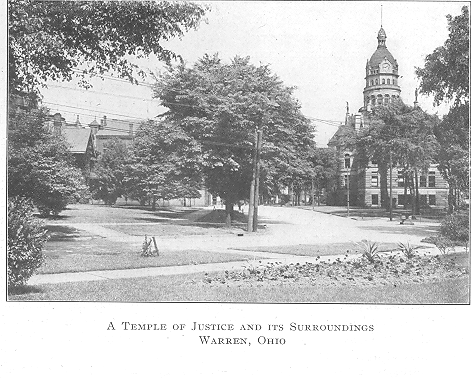
A TEMPLE OF JUSTICE AND ITS SURROUNDINGS
WARREN, OHIO
of the House. The acquittal did not destroy this intense feeling for quite a time. Although the supporters of impeachment did not elect as large a majority in the House of 1809 and 1810 as they held in that of 1808 and 1809, they were able, in January, 1810, to pass what was known as the "Sweeping Resolution" referred to previously. This vacated the offices of all the then Judges of the Supreme Court, all presiding Judges and all the Associate Judges of Common Pleas Courts in every county. It also vacated the offices of Secretary of State, Auditor of State and Treasurer of State. This action on the part of the Legislature, by reason of the broadness of its character, has remained unduplicated in the history of the United States. For a time the State was thrown into a chaotic condition, but subsequently the places were filled again, and the business of the State progressed with its former smoothness.
- 230 -
The last Supreme Court under the old Constitution, consisting of Judges Peter Hitchcock, Rufus P. Spaulding, William B. Caldwell and Rufus P. Ranney, elected by the Legislature, passed out of existence on the 9th of February, 1852, and a new court, elected by the people of Ohio at the previous election in October, 1851, came to the bench, in the persons of Judges William B. Caldwell, of Hamilton County ; Rufus P. Ranney, of Trumbull County ; Thomas W. Bartley, of Richland County ; John A. Corwin, of Champaign County, and Allen G. Thurman, of Ross County. On the organization of the court the Judges drew lots for the length of their terms, resulting as follows : For one year,
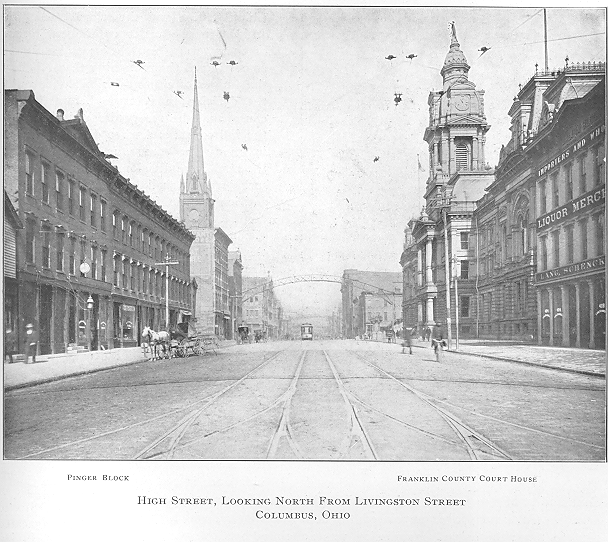
PINGER BLOCK - FRANKLIN COUNTY COURT HOUSE
HIGH STREET, LOOKING NORTH FROM LIVINGSTON STREET
COLUMBUS, OHIO
Judge Caldwell ; for two years, Judge Bartley ; for three years, Judge Corwin ; for four years, Judge Thurman, and for five years, the length of the regular term under the new Constitution, Judge Hitchcock.
The constitution of 1851, which took the power to elect the Judges of the Supreme Court from the Legislature and gave it to the people, contains the following provision for the continuance of the authority of the Supreme Court :
- 231 -
Section II. Schedule. Suits pending in the Supreme Court in bank shall be transferred to the Supreme Court, provided for in this Constitution, and be proceeded with in accordance to law.
Until 1890 the Supreme Court continued to consist of five members. Then, under a new law enacted by the Legislature, the membership of the court was increased to six, and the terms of office extended from five to six years, the term of one Judge expiring with each year. This court is divided into two divisions of three Judges each, the first division consisting of the Chief Justice and the third and fifth Judges in the order of the expiration of their terms, and the second division consisting of the remaining three. When the Judges of either division divide as to the decision in a cause before it, the cause shall be reserved for decision by the full court ; and when different causes involving the same question are before the respective divisions at the same time, such causes shall also be reserved for decision by the full court. If the whole court be divided evenly as to the decision in any cause, the judgment of the lower court shall be entered as affirmed, and such decisions shall be held to be the law as to all such questions in other causes until overruled by a majority of all the Judges. And when the members of the court in any matter of original judgment divide evenly on any question or questions therein, the determination of the members with whom the Chief Justice votes shall be held to be the judgment of the court.
In 1873 an amendment to the Constitution authorized the Legislature to provide once in ten years a Supreme Court Commission of five Judges, to be nominated by the Governor, and confirmed by the State Senate. Governor Hayes appointed the first commission, which sat for three years, from1876 to 1879; the second commission was appointed by Governor Foster. The commission, consisting of five Judges, was in office from April, 1883, to April, 1885. The statutes now require the Supreme Court to hold an annual term, beginning on the Tuesday after the first Monday in January, at Columbus, 0. It may hold special or adjourned terms at such times and places as the Judges, or a majority of them, shall from time to time determine, but, if held elsewhere than in Columbus, thirty days' notice of time and place must be published in Columbus newspapers. The Supreme Court and Supreme Court Library, as well as the
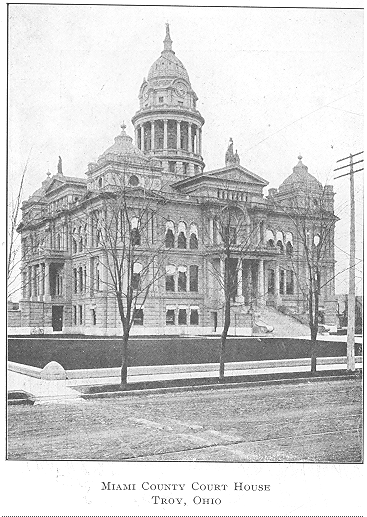
MIAMI COUNTY COURT HOUSE
TROY, OHIO
- 232 -
offices of the Clerk and Reporter of the Supreme Court occupy more than one and one-half floors of space in the new State Judiciary Building.
The Supreme Court Library
The law books forming a part of the State Library were taken to the rooms assigned for the use of the Supreme Court and Law Library in the present Capitol Building as soon as said rooms were ready for occupancy. There is no data obtainable showing just when this change was made, but it was about 1858. At this time the number of volumes could not have exceeded a couple of thousands. In 1866 a count showed about two thousand five hundred volumes. The Library was first in charge of the messenger of the Supreme Court, who was assigned the duty of Librarian. At this time there were two officers of the court, a crier and a messenger. Owing to the illness of the messenger during the greater portion of the year of his service the crier of the court acted as Librarian, and furnished an assistant, who was compensated under an arrangement with the messenger. In 1867 an act was passed providing for the appointment of a Law Librarian, taking effect on the gth of February, 1876, and the positions of crier and messenger of the Supreme Court were abolished, the Law Librarian being made ex-officio crier of the court, said crier to furnish an assistant. For a number of years the listing of the volumes being added to the law library were taken as part of the State Library, and the State Library figures given of the number of volumes enrolled included all those which had 'been set apart as the Law Library of the Supreme Court and additions thereto. This was discontinued early in the '70s, and the first record kept, showing additions to the Law Library, were made in 1873.
From this time on more attention was given to the subject of books, and in 1875 the Library had grown to nearly four thousand volumes. In 1880, when the first catalogue was made, the Library contained about seven thousand five hundred volumes, and on the 1st of March, 1go1, the Library counted a little over twenty thousand volumes. The first messenger and librarian was Richard Riordan, who served two years. He was succeeded by Herman Ruess, in 1860, who served until the 11th of February, 1866. James H. Beebe was acting crier of the Supreme Court, appointed by the Supreme Court on the 6th of

PERRY COUNTY COURT HOUSE
NEW LEXINGTON, OHIO
- 233 -
April, 1865, and reappointed on the 11th of February, 1866, at which time he took charge substantially of the Law Library. On the 16th of February, 1867, a law was passed creating the office of Law Librarian, who, ex-officio, should be the crier of the court. James H. Beebe served in this capacity until his death, on the 12th of July, 1880. Frank N. Beebe, who had been serving as an assistant to his father, was appointed Law Librarian, and succeeded his father in charge of the department on the 13th of July, 1880, and has served continuously up to the time of his death, in October, 1903, when he was followed by the present incumbent in office, Marshal and Librarian of the Supreme Court, Howard E. Gilkey. Under his administration the Library is splendidly cared for and a large number of volumes has been added. This library is considered to be one of the most complete law libraries in the United States.
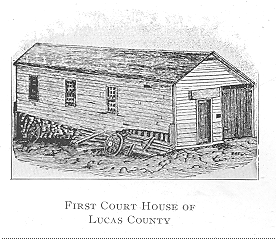
The Circuit Courts of Ohio
These courts were created by the following provision in the Constitution of 1851
"Section 6, Article IV. The Circuit Court shall have like original jurisdiction with the Supreme Court, and such appellate jurisdiction as may be provided by law. Such courts shall be composed of such number of Judges as may be provided by law, and shall be held in each county at least once in each year. The number of circuits and the boundaries thereof shall be prescribed by law. Such Judges shall be elected in each circuit by the electors thereof, and at such time and for such term as may be prescribed by law, and the same number shall be elected to each circuit. Each Judge shall be competent to exercise his judicial powers in any circuit. The General Assembly may change from time to time the number and boundaries of the circuits.” (As amended October 9, 1883, 8o V. 382.)
By an act passed by the General Assembly on the 14th of April, 1884, the State was divided into seven circuits, in each of which the people elected three Circuit Judges for terms of six years.. The first election of Circuit Judges was held in October, 1884, and the first sitting of the several Circuit Courts was fixed for the 9th of February, 1885. The Judges are elected in alternate years, one Judge in each circuit for a term of six years. In 1887 the State was redistricted and an eighth circuit added.
The Courts of Common Pleas
These courts were created under the Constitution of 1802. Regarding these courts, the first Constitution of Ohio contained the following provision:
Article III., Section 3. The several Courts of Common Pleas shall consist of a President and Associate Judges. The State shall be divided by law into three circuits. There shall be appointed in each circuit a President of the Courts, who, during his continuation in office, shall reside therein. There shall be appointed in each county not more than three nor less than two Associate Judges, who, during their continuance in office, shall reside therein. The President and Associate Judges in their respective counties, any three of whom shall be a quorum, shall compose the Court of Common Pleas, which court shall have common law and chancery jurisdiction in all such cases as shall be directed by law ; provided, that nothing here contained shall be construed to prevent the Legislature from increasing the number of circuits and Presidents after the term of five years (et seq.).
- 234 -
The Judges under this provision under the first Constitution were elected by the General Assembly. The terms of the. Common Pleas Courts were fixed by the Legislature, three terms each year in each county. To transact probate business the Judges could hold special terms at any time The number of Common Pleas circuits was from time to time changed and increased as the population increased, and new counties were created. The Constitution of 1851 provides for the election of the Common Pleas Judges by the people. It contained the following provisions by which the State was permanently subdivided into Common Pleas Districts, and these again divided into three sub-districts each :
Article IV., Section 3. The State shall be divided into nine Common. Pleas Districts, of which the county of Hamilton shall constitute one, of compact territory and bounded by county lines, and each of said districts consisting of three or more counties shall be sub-divided into three parts of .compact territory, and bounded by county lines, and as nearly equal in population as practical, in each of which one Judge of the Court of Common Pleas for said district, and residing therein, shall be elected by the electors of said sub-division. Courts of Common Pleas shall be held by one or more of these Judges in every county in the district, as often as may be 'provided by law, and more than one court or sitting thereof may be held at the same time in each district.
Article IV., Section 4. The Jurisdiction of the Courts of Common Pleas and of the Judges thereof shall be. fixed by law. (See Const. 1802, Art. III., 3, 4, 5 and 6.)
The first election of Judges under the new Constitution was held on the second Tuesday of October, 1851. The terms of the old Judges and Clerks

BELMONT COUNTY COURT HOUSE
ST. CLAIRSVILLE, OHIO
were extended by Section 4 of the schedule to the second Monday of February, 1852, at which the new Judges began their term of office. The number of Common Pleas Court districts was increased to ten in January, 1879, when the State was redistricted by the General Assembly, each district having more than three counties contained three sub-divisions ; each subdivision, by popular vote, chose one Judge of Common Pleas for a term of five years. Under later legislation in each sub-division additional Common Pleas Judges were chosen, so that now there' are eighty Judges of Common Pleas in Ohio.
- 235 -
Besides the courts mentioned from 1838 to 1853, one Judge elected for seven years by the Legislature, held the Superior and Commercial Court of Cincinnati ; from 1848 to February, 1853, a like Judge held the Superior Court of Cleveland ; from April, 1854, a Superior Court of the city of Cincinnati has been held by three Judges, chosen by the city voters for terms of five years ; from the 1st of July, 1856, to the 1st of July, 1886, one Judge chosen by the voters of Montgomery County, for a five years' term, held a Superior

LUCAS COUNTY COURT HOUSE IN 1900
TOLEDO, OHIO
Court in Montgomery County ; from March, 1857, to April, 1865, a like Judge, chosen by the voters of Franklin County, held the Superior Court of Franklin County, and from March, 1852, to May, 1854, a like Judge, chosen by the voters of Hamilton County, held the Criminal Court of Hamilton County.
The Insolvency Courts
The Courts of Insolvency were created by an act of the Seventy-first General Assembly, as follows :
"There shall be and hereby is established in any county of this State, containing any city of the first grade of the first class, a court of record, which shall be styled "The Court of Insolvency." It shall consist of one Judge, who shall be elected by the electors of such county."
- 236 -
"The first election for such Judge shall be held on the first Tuesday after the second Monday in November, 1894, and shall be conducted in the same manner and governed by the same laws that are now in force or may hereinafter be enacted regulating the election, of Judges in the State. The term of office shall commence on the 9th day of February, 1895, and shall continue for the term of five years."
Under the above laws the Insolvency Court of Hamilton County was established, and the first Judge of said court, Aaron McNeill, was elected on the date mentioned above. The Seventy-second General Assembly extended the Insolvency Courts to "any county of this State containing any city of the second grade of the first class," and under this law the Insolvency Court of Cuyahoga County was established, the first Judge of which took his seat on the 9th of February, 1897.
Until 1900 the jurisdiction of the above-named courts was confined to bankruptcy cases, but on the 16th of April, 1900, the following act of the General Assembly was passed, which enlarged the scope of the Insolvency Courts :
"Section 2. The said Courts of Insolvency shall have jurisdiction concurrent with the Probate Courts of such counties, in allowing and issuing writs of habeas .corpus, and determining the validity of the caption and detention of the persons brought before it on: such writs; also, to make inquests of the amount of compensation to be made to the owners of real estate when appropriated by any corporation, legally authorized to make such appropriation. And from orders, decrees and jugments, in such cases, appeals may be taken: to the Court of Common Pleas, and error may be prosecuted with the Court of Common Pleas, in the same manner and to the same extent in all respects, as is provided in such cases respectively when pending in the Probate Court."
The Probate Courts
Under the first Constitution exclusive jurisdiction in probate and testamentary matters was vested in the Courts of Common Pleas, and the orders of those courts made in the progress of such matters could not be reviewed in the Supreme Court upon writ of error.
Article III., Section 5. The Court of Common Pleas in each county shall have jurisdiction of all probate and testamentary matters, granting administration, and such other cases as shall be prescribed by law.
The Constitution of 1851, after creating the Probate Courts, defines their duties as follows :
Article IV., Section 8.—The Probate Court shall have jurisdiction in probate and testamentary matters, the appointment of administrators and guardians, and such jurisdiction in habeas corpus, issuing of marriage licenses, and for the sale of land by executors, admin- istrators and guardians, in any county or counties, as may be provided by law.
Besides the jurisdiction given to the Probate Court by the Constitution of 1851, the General Assembly gave that court power in many cases and proceedings not requiring a jury and jurisdiction of Jury cases for appropriations of property for public use, and considerable minor criminal jurisdiction.
The Courts of the Justices of the Peace
are also an integral part of the judiciary system of Ohio. These courts were created by the first Constitution, in 1802, as specified in Article III., Section 11—A competent number of Justices of the Peace shall be elected by the qualified electors in each township in the several counties, and shall continue in office three years, whose powers and duties shall, from time to time, be regulated and defined by law.
A similar clause confirming the above w.as embodied in the Constitution of 1851.
- 237 -
The Judiciary of Ohio has always been of the highest order, and members of it have sustained the good name of the State. The following contributions have been made by the Ohio bench, during the last hundred years, to positions of great responsibility and trust in the service of the State and Nation :
Eight Governors of Ohio, for terms aggregating twenty-two years ; three Justices of the United States Supreme Court, for terms aggregating forty years; one Secretary of State ; two Attorney-Generals ; two Secretaries of War ; two Postmaster Generals of the United States, for terms aggregating twenty-one years ; one Governor General of the Philippines; nine United States Senators, for terms aggregating seventy-six years, and forty-two members of the National House of Representatives, for terms aggregating one hundred and fifty-eight years.
- 238 -
EDUCATIONAL FACILITIES
Development of Ohio's Public School System
Early School History.—Provisions for Maintaining Educational Institutions.—Allotment of Lands for School Purposes.—A General History of the State School System.—Statistical Information .—The Columbus Public School Library.—Legislative Enactments.—Private Schools.—Creation of High and Normal Schools.
IN 1903 the population of Ohio numbered 4,157,545. This teeming population necessarily spread all over the State. The primeval forests had disappeared, and the plains had changed into fertile farmlands, cultivated by an industrious, busy people. Cities, towns, villages and hamlets had sprung up, and everywhere could be seen the signs of civilization and progress. Factories and tremendous industrial enterprises flourished ; pretty, ornamental and comfortable residence's were erected; farmhouses and roomy barns dotted the land; cultivated fields took the place of the hunting grounds of the red men ; endless railway and traction lines girded the State from East to West and North to South ; magnificent churches of varied denominations displayed their spires to the heavens and thousands of schoolhouses, from the. smart one-room "red schoolhouse" to the palatial building, devoted to modern education, were in evidence. The public free school system of Ohio must be linked in history to the school system of the New England States. That it would be impossible to grant important civic rights to the people without providing the means for their proper education has been foreseen by our forefathers. To permit the exercise of suffrage and the control of the affairs of the Nation itself to the people in general without providing education for all and a consequent spread of intelligence, would mean the undermining of the very foundation of the Republic. In order to be free in every sense of the word, the people had to be educated. These conditions were recognized even before the War of the Rebellion, and the literature of the later Colonial and Revolutionary periods abound in reference to the necessity of education. The New England free school, as well as later the free school system of Ohio, was the outgrowth of the spirit of Democracy. The immortal Washington splendidly voiced this sentiment when he wrote in his farewell address : "Promote, then, as an object of primary importance, institutions for the general diffusion of knowledge. In proportion as the structure of a government gives force to public opinion, it is essential that public opinion should be enlightened." The public school system of today is not the work .of one man, or of one period. It is the result of necessary circumstances, a development, an evolution. At first the public school system was a community necessity, later a definitely recognized institution. Spontaneity had been its keynote from the beginning. Its worth has been recognized in town meetings, in colonial assemblies, in State constitutions, in State legislations, as well as in the halls of the National Congress. Every State and Territory has helped to build up the public school system of the United States, and it may truthfully 'be said that the State of Ohio has nobly done her share.
It was on the loth of May, 1785, when, by act of Congress, then operating under the old articles of Confederation, the public lands of the Government were ordered to be surveyed in townships, six miles square, Section Sixteen of each township being reserved for common school purposes. The famous "An Ordinance for the Government of the Territory Northwest of the River Ohio," was enacted on the 13th of July 1787. Said ordinance contained 'a strong declaration in Article III. relating to education, which reads in part :
"Religion, molarity and knowledge, being necessary to good government and the happiness of mankind, schools and the means of education shall forever be encouraged."
Ten days after Congress had passed this ordinance, whose strong words are here noted as related to education, and with equally significant utterance on religious freedom, the
- 241 -
habeas corpus, trial by jury, prevention of slavery in the Northwestern Territory, inviolability of contracts and the like, a very important act, often lost sight of, was also passed. This act was supplementary to the one passed on the loth of May, 1785, relating to the survey and sale of the public lands. In addition to setting aside every sixteenth section of each township for common school purposes, it also ordered that two whole townships were "to be given perpetually for the purposes of a seminary of learning, to be applied to the intended object by the Legislature of. the State." In this way Congress prepared the way, for irreduceable school funds, by means of Section sixteen, and also began the work of
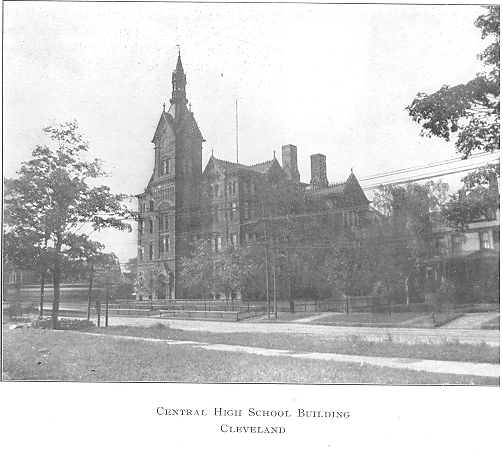
CENTRAL HIGH SCHOOL BUILDING
CLEVELAND
higher education at State expense, the Ohio University at Athens being the beneficiary of the two townships referred to.
When, in compliance with the enactment of Congress, "the people of the Eastern division of the Territory of the United States, northwest of the River Ohio," adopted a State Constitution in 1802, shortly before the admission of Ohio into the Union as a State, they did not neglect the cause of education. In the third section, in their bill of rights (Article VIII., of the Constitution), they reaffirmed, slightly changed, the third article of the Ordinance of 1787, as follows :
Section 3.—But religion, morality and knowledge, being essentially necessary to good government and the happiness of mankind, schools and the means of instruction shall
- 242 -
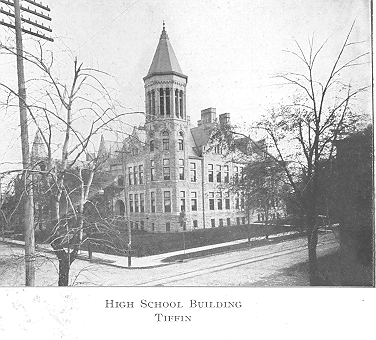
HIGH SCHOOL BUILDING
TIFFIN
forever be encouraged by legislative provision, not inconsistent with the rights of conscience.
Not less important than Section 3 are Sections 25 and 27 of the first Constitution of Ohio :
Section 25. No law shall be passed to prevent the poor in the several counties and townships within the State from an equal participation in the schools, academies, colleges and universities within the State, which are endowed in whole or in part from the revenue arising from donations made by the United States for the support of schools and colleges ; and the doors of said schools, academies and universities shall be open for the reception of scholars, students and teachers of every grade, without any distinction or preference whatever, contrary to the intent for which said donations were made.
Section 27. Every association of persons, when regularly formed, within the State, and having given themselves a name, may, on application to the Legislature, be entitled to receive letters of incorporation, to enable them to hold estates, real and personal, for the support of their schools, acadamies, colleges, universities, and for other purposes.
In one way and another the gifts of land to Ohio for educational purposes have exceeded twelve hundred square miles. What other country in the world can boast of such a magnificent estate devoted to this noble purpose? It is possible that at the' time of the adoption of the First Constitution of Ohio the expectation was that the several gifts would in time support the entire school system of "schools, academies, colleges and universities." As there was an almost limitless area of land, and as the country was rapidly being settled, this endowment, it was anticipated, would be certain to increase greatly in value, and thereby meet the necessities of its original intent. But these gifts were soon shown to be entirely inadequate for self-support, for as early as 1821 the State Legislature passed a law authorizing a school tax.
The second Constitution of Ohio, that of 1851, which is still in force, contains a number of sections, relating to education, of vital importance. The declarations of the old Constitution, referring to religion, morality and knowledge, were substantially repeated, as follows :
Article I., Section 7. Religion, morality and knowledge, however, being essential to good government, it shall be the duty of the General Assembly to pass suitable laws to protect every religious denomination in the peaceable enjoyment of its own mode of public worship, and to encourage schools and the means of instruction.
To permit elasticity and the referendum in school matters—while all general laws, including school laws, are to have uniform operation throughout the State—the following section was included in the second Constitution :
Article II., Section 26. All laws of a general nature shall have a uniform operation throughout the State ; nor shall any act, except such as related to public schools, be passed,
- 243 -
to take effect upon the approval of any other authority than the General Assembly, except as otherwise provided in this Constitution.
In Article VI., which is entirely devoted to education, there are two sections, historically and practically very important.
Article VI., Section 1. The principal of all funds arising from the sale or other disposition of lands, or other property, rented or entrusted to this State for educational or religious purposes, shall forever be preserved inviolate and undiminished ; and the income
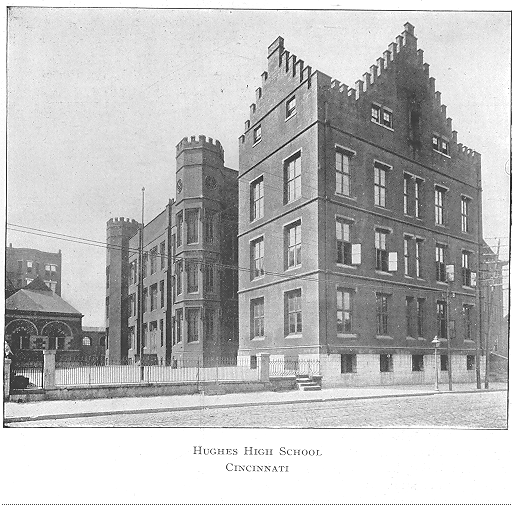
HUGHES HIGH SCHOOL
CINCINNATI
arising therefrom shall be faithfully applied to these specific objects of the original grants or appropriations.
Section 2. The General Assembly shall make such provisions, by taxation or otherwise, as, with the income arising from the school trust fund, will secure a thorough and efficient system of common schools throughout the State; but no religious or other sect, or sects, shall ever have any exclusive rightto, or control of, any part of the school funds of this State.
Article XII. provides for the following:
- 244 -
Article XII., Section 2. Laws shall be passed taxing, by a uniform rule, all moneys credits, investments in bonds, stocks, joint stock companies, or otherwise ; and also all real estate and personal property according to its true value in money ; but burying grounds, public schoolhouses, houses used exclusively for public worship, institutions of purely public charity, public property used exclusively for any public purpose, and personal property, to an amount not exceeding in value two 'hundred dollars for each individual, may, by general laws, be exempted from taxation ; but all such laws shall be subject to alteration or repeal, and the value of all property so exempted shall, from time to time, be ascertained and published, as may be directed by law.
In the last year of the first century of her Statehood Ohio had a population of 4,157,545, and an enumeration of 1,245,393 of all youth between the ages of six and twenty-one years. Under the laws of the State the schools are to be free to all who are children or wards of residents of the district and who are between six and twenty-one years of age. All are admitted free ; no discrimination exists as to color. All children between eight and fourteen years must attend some recognized school for the full time the public schools for the district are in - session, and all youth
between fourteen and sixteen, not regularly engaged in some useful labor, or who can not read and write, must also attend some recognized school. Boards of Education are, by law, required to appoint truant officers and carry out the provisions relating to .attendance. The shortest term of a school allowed under. the compulsory education laws of Ohio is twenty-four weeks, and the longest term forty weeks. Every summer the Boards of Education are required to cause an annual enumeration, in their respective districts, to be taken. Upon these enumerations the State Auditor makes his semi-annual distributions of the State common school fund to each county. Within her history as a State Ohio has .raised and spent fully five hundred million of dollars for the public schools. In the
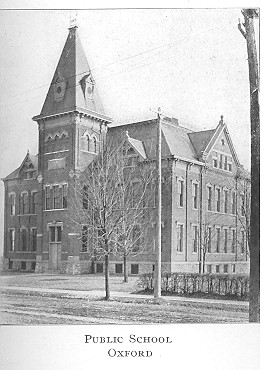
PUBLIC SCHOOL
OXFORD
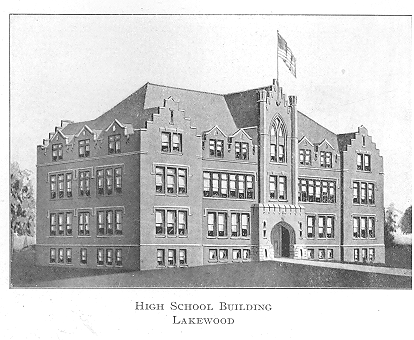
HIGH SCHOOL BUILDING
LAKEWOOD
- 245 -
last year of the first century of Ohio's Statehood the expense for the public school system amounted to $16,463,216.02. Of this enormous sum $9,267,638.94 were paid to teachers; $44.4,361.54 for supervision; $1,549,523.06 for sites and building; for interest and redemption of bonds, $1,594,217.04; and for the contingent expenses, $3,607,474.44. The sources of the funds were, from the State tax, $1,817,767.58; from the school lands, $249,159.87; and the remainder from' local sources. At the time mentioned there were 2,437 separate school districts in. Ohio, namely, 66 city districts, 1,036 village and special districts and 1,335 township districts. More than 13,135 schoolhouses were necessary for the purposes of the public school system. Of these were in township districts, 11,007 elementary schools, and 111 high schools. In separate districts were 1,770 elementary schools, and 247 high schools, a total of 12,770 elementary schools and 358 high schools. The buildings devoted to the above purposes had 22,545 school rooms; the value of the property was as follows: Elementary schools, $41,903,353, and high schools, $6,354,608. In these schools 822,050 children were enrolled. The number of boys in the township districts amounted 180,777; girls, 164,986. In the high schools, boys, 3,096; girls, 3,108. In separate districts, elementary schools, boys, 207,160; girls, 210,616. In the high schools, boys, 22,733; girls, 29,574.
The attendance of the universities and colleges in Ohio amounted to 8,306. In private schools, including parochial schools, were 27,133 pupils ; 3,662 were in the different State institutions, and 716 attended the schools for deaf children. The different school libraries contained 44,088 volumes. To teach this .enormous number of pupils, an army of 26,410 teachers was necessary. Of these, 24,230 taught in the elementary schools and 2,180 in the high schools; 9,913 teachers were men and 16,497 women. A half century ago the State undertook the work of encouraging a growth of libraries in all the school districts of the State, the State Commissioner of Schools being authorized to make selections and distribute the books provided by the General Assembly. This plan for a time worked well, but finally was discontinued and the distribution of these books was placed in the hands of the different Boards of Education, who were authorized to make purchases and build up libraries. Later special acts were passed for certain districts, while some general law existed -on the subject. A very important general law was passed in the extraordinary session of 1902, which framed the New Code for the Ohio Municipalities, authorizing the Board of Education of any city, village or special district to provide for the establishment, control and maintenance in each school district of a public library, free to all the inhabitants of such district. While nearly all the public schools of Ohio, especially those in the larger cities, have more or less well equipped libraries, the city of Columbus enjoys the distinction of having the finest and most complete public school library in the State, if not in the whole United

HIGH SCHOOL BUILDING
BELLAIRE
- 246 -
States. This library occupies an entire building specially erected for its purpose. It is a model, and deserves special mention in a work of this character, as it shows what can be done and what should be done in the different centers of the State of Ohio in the same field of endeavor. The probable date of the origin of this public school library was 1847, although the records showing its origin are not available.
From this probable, date--1847—up to the year 1873, the public school library was under the care of the superintendent and principals of the high schools and grammar schools. Such records as there are show that in 1853 the public school library contained 1,830 volumes, valued at $900. In 1873, it was decided to remove them to the public library. At that time the invoice showed that there were but 1,500 volumes owned by the schools.
The public school library was jointly managed with the public library, or city library, until 1891, during which time a gain of nearly 12,000 volumes was made.
Since June, 1891, at which time the transfer of the school library was made to its present home, the growth of that institution has been rapid. Many departures from the ordinary set methods of merely handing out books over the front counter have been made, the chief of which are to be enumerated and explained later on.
A supplementary reading department, one of the suggestions of the Superintendent of Schools, Mr. J. A. Shawan, was established shortly after the transfer was made. This supplementary department provides books for use in the schools, and is drawn upon by the teachers, at the suggestion of the Superintendent.
By its establishment pupils in the higher grades of the elementary and high schools are enabled to break away from the dry lessons of their text-books, and to take up, systematically, the work of reading.
The supply of supplementary reading books is increasing to such an extent that where frequently orders were placed at least six months, and from that to the full length of the term, now the librarian is able to supply teachers in a much shorter time
The reference library, in connection with the school library, is another important factor in the system of education. With reference to this department Librarian Hensel says:
"The old idea of education by filling the mind of the child with abstract facts and figures, which, to him, have no significance, nor any relation to each other,- is fast giving way to the newer idea of teaching the pupil
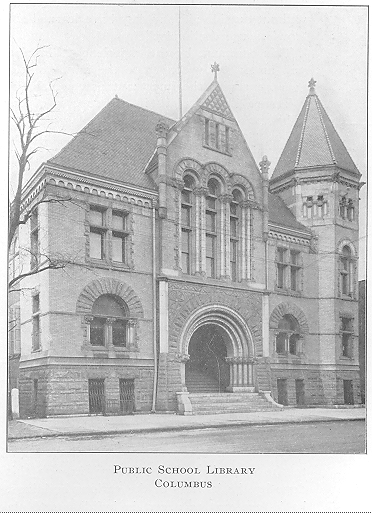
PUBLIC SCHOOL LIBRARY
COLUMBUS
- 247 -
how and where to find them when he needs them. This leads directly to the use of reference books, and, incidentally, to the 'how' to use them.
"There can be no more objection to teaching the use of reference books in the schools than there is to teaching reading there ; the public library profits by either, and most by both. In fact, the two things are inseparable, for intelligent reading is impossible without consulting dictionaries, encyclopedias or other works by different authors bearing upon the same subject. Nothing leaves a stronger impression upon the mind than to see the same object or view the same incident from several directions, while studying it. The pupils in the Columbus schools begin to use them in the fifth or sixth year ; by the time they enter the high school they have become somewhat proficient in handling them.
"When pupils come to the library to look up information on any subject, they do not hesitate to ask for precisely what they want ; securing the books they are able to find them without outside aid, for they have learned the `how' to use the books."
This comment by the experienced librarian will undoubtedly convey to the minds of the average reader the important part which the reference library plays in the success of the public school library as a whole.
The "branch library" system, established by Librarian Hensel in November, 1896, has become a feature in the work. It has passed from the experimental to the successful stage ; and from the establishment of several small branch libraries in the outlying schools, especially during the winter months, when it became almost impossible and a hardship for
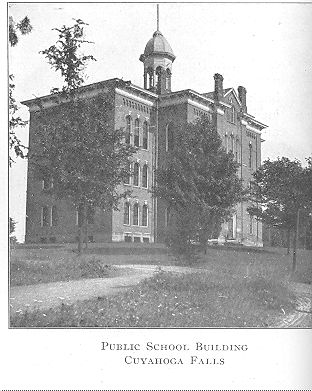
PUBLIC SCHOOL BUILDING
CUYAHOGA FALLS
pupils living far from the base of supplies to (each the city as often as desired, the branch libraries have grown until at the present time there are twenty-six of them in existence, and plans for even more extensive distribution are well under way.
It is the policy of the library to add to the number of these 'branches gradually until every elementary building desiring such a branch shall be supplied, and then increase the number of volumes in each branch.
At present about 100 volumes are sent to these libraries, although in some cases, and especially in the larger buildings, or where the capacity for operating them is better, 25 or 3o additional volumes are added to the list.
The plan of operating the branch libraries is a simple one ; there is no expense added to the operation of the library through this plan, as the work of delivering the books is done by the janitors of the various buildings. For instance, 100 volumes of fiction or other books are sent to a certain building and placed in the care of the principal. Pupils of that school are allowed to draw upon these volumes until exhausted, of course, presenting their cards and receiving credit for returns and being charged for books taken out in the same
- 248 -
manner as is done at the school library counter. The libraries are moved from one building to another, and a fresh supply of reading for the pupils is kept constantly on hand.
The scope of that library is not confined exclusively for the benefit of the children of the public schools, as the residents generally of the city are entitled to the use of the books. Further more, branches of the system extend to the different engine houses of the city, as well as to the city prison, in which latter institution the books are disseminated among the inmates. The records of the Columbus Public School Library for the last decade of the first century of Ohio's Statehood show a remarkable increase in the number of volumes on the shelves and also in the distribution o f the books. For four and one-half months, ending August 31, 1892, there were 16,318 books distributed for home use ; 761 in the sup-
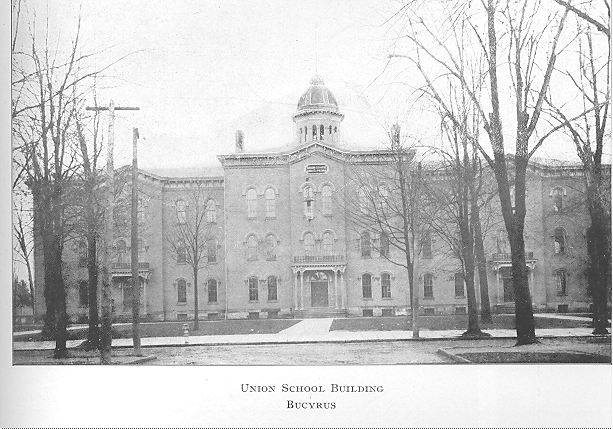
UNION SCHOOL BUILDING
BUCYRUS
plementary reading department ; 1,777 used in the reference department, the total service being 18,856 volumes.
For the year ending August, 1903, the service is given as follows : Circulating department, 216,680 volumes; reference department, 304,616 volumes ; total, 521,296 volumes. These figures show an increase in the service of 502,440 volumes in fourteen years.
The so-called irreducible State debt of Ohio is in reality a great trust fund. Ohio, instead of creating a large permanent fund, t o be loaned on mortgage security, as was done in Massachusetts, Kansas and many other States east and west of us, provided early in
- 249 -